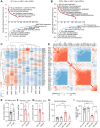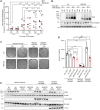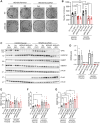Decreased mitochondrial NAD+ in WRN deficient cells links to dysfunctional proliferation
- PMID: 40179319
- PMCID: PMC12074813
- DOI: 10.18632/aging.206236
Decreased mitochondrial NAD+ in WRN deficient cells links to dysfunctional proliferation
Abstract
Werner syndrome (WS), caused by mutations in the RecQ helicase WERNER (WRN) gene, is a classical accelerated aging disease with patients suffering from several metabolic dysfunctions without a cure. While, as we previously reported, depleted NAD+ causes accumulation of damaged mitochondria, leading to compromised metabolism, how mitochondrial NAD+ changes in WS and the impact on WS pathologies were unknown. We show that loss of WRN increases senescence in mesenchymal stem cells (MSCs) likely related to dysregulation of metabolic and aging pathways. In line with this, NAD+ augmentation, via supplementation with nicotinamide riboside, reduces senescence and improves mitochondrial metabolic profiles in MSCs with WRN knockout (WRN-/-) and in primary fibroblasts derived from WS patients compared to controls. Moreover, WRN deficiency results in decreased mitochondrial NAD+ (measured indirectly via mitochondrially-expressed PARP activity), and altered expression of key salvage pathway enzymes, including NMNAT1 and NAMPT; ChIP-seq data analysis unveils a potential co-regulatory axis between WRN and the NMNATs, likely important for chromatin stability and DNA metabolism. However, restoration of mitochondrial or cellular NAD+ is not sufficient to reinstall cellular proliferation in immortalized cells with siRNA-mediated knockdown of WRN, highlighting an indispensable role of WRN in proliferation even in an NAD+ affluent environment. Further cell and animal studies are needed to deepen our understanding of the underlying mechanisms, facilitating related drug development.
Keywords: NAD+; Werner syndrome; mitochondria; premature aging; proliferation.
Conflict of interest statement
Figures




Similar articles
-
NAD+ augmentation restores mitophagy and limits accelerated aging in Werner syndrome.Nat Commun. 2019 Nov 21;10(1):5284. doi: 10.1038/s41467-019-13172-8. Nat Commun. 2019. PMID: 31754102 Free PMC article.
-
Genetic correction of Werner syndrome gene reveals impaired pro-angiogenic function and HGF insufficiency in mesenchymal stem cells.Aging Cell. 2020 May;19(5):e13116. doi: 10.1111/acel.13116. Epub 2020 Apr 22. Aging Cell. 2020. PMID: 32320127 Free PMC article.
-
Aging stem cells. A Werner syndrome stem cell model unveils heterochromatin alterations as a driver of human aging.Science. 2015 Jun 5;348(6239):1160-3. doi: 10.1126/science.aaa1356. Epub 2015 Apr 30. Science. 2015. PMID: 25931448 Free PMC article.
-
Crosstalk among DNA Damage, Mitochondrial Dysfunction, Impaired Mitophagy, Stem Cell Attrition, and Senescence in the Accelerated Ageing Disorder Werner Syndrome.Cytogenet Genome Res. 2021;161(6-7):297-304. doi: 10.1159/000516386. Epub 2021 Aug 25. Cytogenet Genome Res. 2021. PMID: 34433164 Free PMC article. Review.
-
Werner syndrome (WRN) gene variants and their association with altered function and age-associated diseases.Ageing Res Rev. 2018 Jan;41:82-97. doi: 10.1016/j.arr.2017.11.003. Epub 2017 Nov 14. Ageing Res Rev. 2018. PMID: 29146545 Review.
Cited by
-
Multi-omics analysis of canine aging markers and evaluation of stem cell intervention.Commun Biol. 2025 Jun 10;8(1):905. doi: 10.1038/s42003-025-08333-z. Commun Biol. 2025. PMID: 40494876 Free PMC article.
References
MeSH terms
Substances
Grants and funding
LinkOut - more resources
Full Text Sources
Miscellaneous

